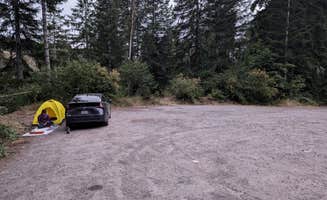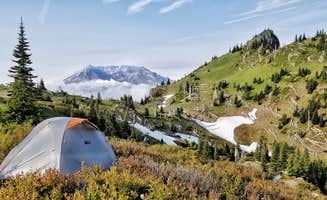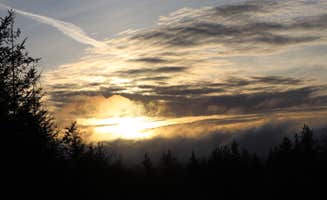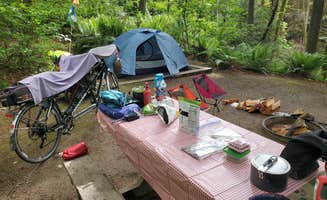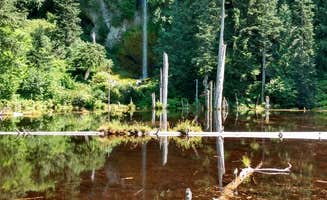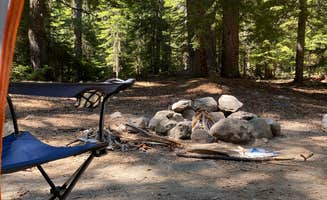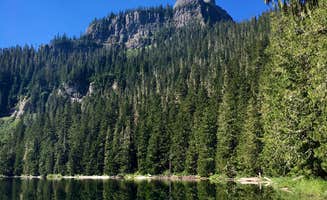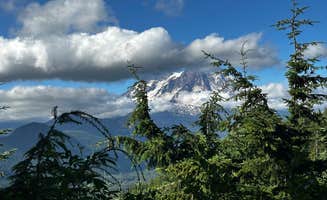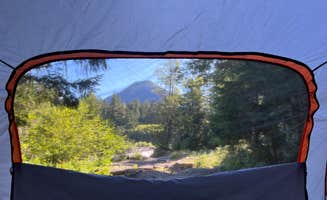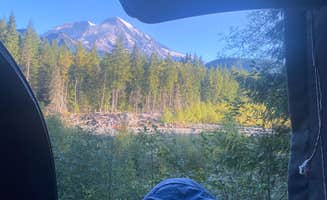Dispersed camping near Napavine, Washington offers access to multiple Forest Service roads with varying elevation gains from 800 to 3,500 feet. The surrounding Gifford Pinchot National Forest encompasses over 1.3 million acres with diverse ecosystems ranging from old-growth forests to volcanic landscapes. Most dispersed sites require self-contained waste management as forest service roads rarely provide facilities beyond occasional temporary toilets.
What to do
Waterfall hiking: 3-mile round trip to Beaver Falls. Beaver Falls Trailhead provides overnight parking and access to a short scenic trail. As one visitor notes, "The hike to the falls is to the far left of the pullout. Do NOT go down the super steep trails to the right. Beautiful waterfall after a short hike." The site works well for car camping with "a large pull out on a quiet road in the woods."
Mountain goat watching: Best in summer months. The dispersed areas around Mount St. Helens Dispersed Camping offer wildlife viewing opportunities. A camper reported, "We visited in early September and found the weather to be very pleasant. Our view of Mt. St Helen's was obscured by the tall trees that offered our site seclusion and privacy, but we relished the view of the active volcano while driving to and from our site."
Mushroom foraging: August-September. The forested areas near Butte Camp Climbers Bivouac offer excellent foraging opportunities. As one visitor explains, "The forest has majestic trees and when it rains, it resembles a rainforest. During August and September, you can find tons of edible mushrooms."
What campers like
Solitude: Weekday camping. Many dispersed sites around Napavine offer privacy, especially mid-week. At Road to Snag Lake, campers appreciate the isolation: "We stayed on a Friday night in August and were the only ones here. Amazing views and complete silence! Tons of rabbits and wildflowers."
Cell coverage: Variable but predictable. Campgrounds around Napavine have surprisingly good connectivity in specific locations. At Rock Candy Mountain Trailhead, a camper noted, "The parking lot has many signs saying no camping. On the way into the parking though, there are three spots on the side of the road. Set up camp there." Regarding connectivity, many sites offer unexpected service, like Snag Lake where one visitor mentioned, "I've got T-Mobile and had full bars."
Budget-friendly options: Mostly free. NF-52 Dispersed Camping provides affordable access near Mount Rainier. One camper shared: "We found an awesome walk in spot a little bit earlier on the forest road before these actual coordinates. While we didn't have the comfort of our car parked right next to us, we had spectacular views of Mt. Rainier, easy access down to the river, and a fire pit."
What you should know
Road conditions: Varying grades. Forest roads require appropriate vehicles and caution. At Road to Snag Lake, a visitor warned: "Long steep gravel road to get here but good spot with great cell reception." Another noted: "Road is gravel but in great condition, even passenger cars will be totally fine."
Fire regulations: Seasonal restrictions. Most dispersed sites around Napavine allow fires in existing rings except during high fire danger periods, typically July-September. Always check current restrictions before your trip.
Bathroom facilities: Extremely limited. Joemma Beach State Park Campground stands out for having toilets when most dispersed sites have none. A camper reported, "Simple, small, peaceful campground with pit toilets and potable water. Mid week after Labor Day, I had my choice of sites arriving in late afternoon."
Permit requirements: Discovery Pass needed. Most Washington State dispersed camping requires a Discovery Pass ($12/day or $35/year). One visitor at Snag Lake noted, "This site is listed as free, but there is a sign at the entrance for needing a discovery pass to use the site. Visit their website for payment options. You have to print the pass or write the transaction number on a paper and on your windshield."
Tips for camping with families
Safety first: Monitor steep edges. Many camping areas have drop-offs that require supervision with children. At Rock Candy Mountain Trailhead, a camper warned: "Where we stayed was slightly sketchy, lots of trash." Another noted about a different forest road: "I feel if you did [fall] and survived the fall it would be expensive to recover your vehicle."
Wildlife experiences: Morning viewing. Early risers have the best chances to spot wildlife. At Cora Lake Back Country, families report: "Tons and tons of frogs and tadpoles which meant no bugs! Beautiful area." This 3-mile hike is accessible for older children: "Walked up for a night. Youngest was 11. Told the kids it was a 2 hour walk. Did it in under an hour."
Short hikes: Kid-friendly options. Several dispersed sites offer manageable trails for families. At Beaver Falls Trailhead, one visitor shared, "Relative to other options in Northwest Oregon this was an easy to find, plenty of space place to park the car. My partner and I angled our vehicle to block our tent from the road and slept like rocks."
Tips from RVers
Parking considerations: Length restrictions. Most forest service roads have limited turning space for larger rigs. At Mount St. Helens Dispersed Camping, a visitor advised: "There are many spots to choose from for cars, trucks, and vans. It doesn't seem like it's designed for RV's and trailers."
Leveling challenges: Limited flat areas. Many dispersed sites have uneven terrain. One camper at Beaver Falls Trailhead mentioned, "Only downside is it's not perfectly flat. It wasn't too bad though. I just parked with my head pointing uphill when I go to bed, of course."
Seasonal access: Winter limitations. Most forest service roads become impassable for RVs from November through April due to snow and mud. Spring conditions can be particularly challenging with washouts and soft shoulders.


